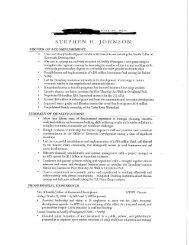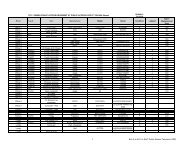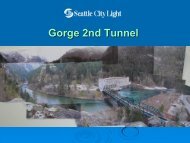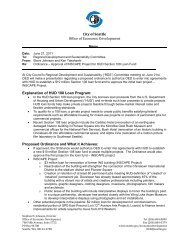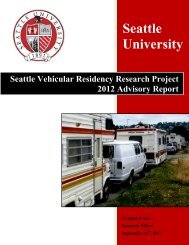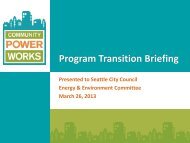2013 Water System Plan, Volume II - Seattle City Clerk's Office - City ...
2013 Water System Plan, Volume II - Seattle City Clerk's Office - City ...
2013 Water System Plan, Volume II - Seattle City Clerk's Office - City ...
Create successful ePaper yourself
Turn your PDF publications into a flip-book with our unique Google optimized e-Paper software.
ange of available sizes, steel pipe size may need to be reduced in the<br />
immediate vicinity of the ball joints. See Virtual Vault plan set 785-38 for an<br />
example of an 89-inch OD steel pipe crossing a slide plane with a 48-inch double<br />
ball expansion joint.<br />
Where fault crossings/slide planes are encountered, a double ball expansion joint should be<br />
installed right at the fault crossing as shown in Virtual Vault plan set 785-38. If this is not<br />
possible, the thickest pipe wall and strongest steel should be used, with some flexibility built in<br />
elsewhere if possible.<br />
Design considerations such as predicted ground movement, installation cost, cost of failure, and<br />
reliability must be analyzed. It may be cheaper to install an inexpensive pipe system and replace<br />
it every 10 years than to install a system that will last 100 years. Some SPU pipelines are<br />
extremely critical and must be designed to withstand the largest expected ground movement.<br />
5.8.4.3 Seismically Actuated Valves<br />
Seismically actuated valves automatically close during an earthquake to prevent the<br />
uncontrolled drainage from water storage tanks due to broken downstream pipelines. Many<br />
factors must be determined for each valve installation: sensitivity, speed to close, battery life<br />
requirements, power availability, and SCADA.<br />
The seismic actuator must be properly matched to the valve it protects.<br />
All valves must have a manual operator for emergency operation.<br />
5.8.5 Inter-Connection of Parallel Mains<br />
In some cases, pipelines may be installed parallel, or a new line may be installed near an existing<br />
main. The design engineer should consider whether a connection between the two pipelines is<br />
possible and beneficial. A primary reason to consider the interconnection is draining of the<br />
pipelines. Typically, when a pipeline is drained, millions of gallons of water are wasted. Pumping<br />
from pipeline to pipeline allows for much faster draining than can normally be achieved by<br />
draining to the water system. If parallel or nearby pipelines are interconnected, water from the<br />
pipeline to be drained can be pumped into the other pipeline, thus not wasting water.<br />
The interconnection between mains will likely require room for a pump. If possible, route an<br />
interconnection line from each pipeline into a single vault, leaving a gap for a pump and the final<br />
connecting piping. The size of the interconnection should be based on flow calculations and an<br />
acceptable amount of time to drain the line. A good location for an intertie is at the blow-off.<br />
5.8.6 Rehabilitation of Existing Mains<br />
See DSG section 5.6.5.<br />
5.8.7 Emergency Pump Connections<br />
See DSG section 5.6.6.<br />
5.8.8 SCADA<br />
See DSG section 5.6.7.<br />
5-46 SPU Design Standards and Guidelines



